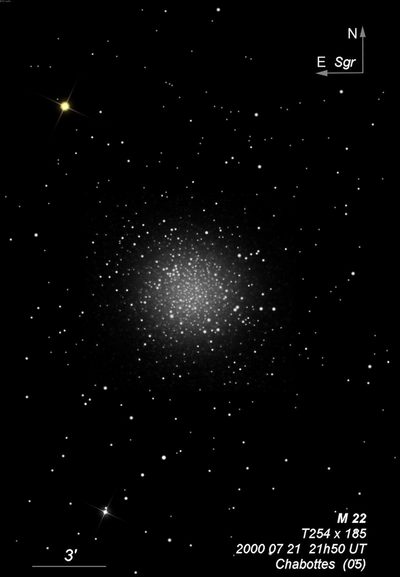
Naked eye: This is the third brightest globular in integrated magnitude (V = 5.2) and generally a difficult naked-eye object in a dark sky from northern California. It was a fairly easy naked-eye from Australia, though not as obvious as I expected.
Johann Abraham Ihle discovered M22 = NGC 6656 = Lac I-12 = h2015 = h3753 on 26 Aug 1665 during an observation of Saturn. This was the first globular cluster discovered. It was reported that Hevelius had seen it earlier, but he didn't include M22 in his list. Edmond Halley observed and included this globular in his 1715 list of six nebulae. Nicolas-Louis de Lacaille observed M22 on 6 Apr 1752 with a 1/2" telescope at 8x, during his expedition to the Cape of Good Hope. William Herschel noted it was "All resolved into stars" on 4 Jul 1783 using his 12-inch reflector (small 20-foot). On 12 Jul 1784 (sweep 236), he called it "a most beautiful extensive cluster of stars of various magnitudes, very compressed in the middle. R and about 8' dia besides the scattered ones which do more than fill the extent of the field, L, r."
From the Cape of Good Hope, John Herschel recorded (sweep 793), "globular cluster; vB; vL; vm comp; vgvmbM; 7' diam. The stars are of two magnitudes, viz., 15..16m and 12m; and what is remarkable, the largest of these latter are visibly reddish; one in particular, the largest of all (= 11-12m) sf the middle, is decidedly a ruddy *, and so I think are all the other large ones."
200/250mm - 8" very bright, very large, extremely rich. A few hundred mag 11-13 stars were resolved and the globular appeared highly resolved down to the core. A bright clump as visible in the NE section of the core. The cluster contained a wide variation of magnitudes. M22 is the second best globular for viewing from Northern California (next to M13), although it has brighter members).
400/500mm - 17.5" (8/4/94): at 220x appears 10' diameter although outliers may significantly increase the total diameter. The very bright core appeared irregularly round and 3.5'-4' diameter but not concentrated to the center. M22 was extensively resolved to the center and there was no distinct nucleus. At the NE edge of the core I noticed a rich small clump with 8-10 stars that collectively stood out well and an easy bright pair at the SE edge of the core. The very irregular halo appeared more extensive on the NE side and seemed elongated SW-NE. Dark lanes appeared to intrude into the cluster and involve the surrounding region, though this may be an optical effect.
600/800mm - 24" (7/21/12): M22 displayed a few distinct orange/red supergiants. Two colored stars are on the southwest and southeast side of the core. A third fainter star forming an isosceles triangle to the north (closer into the core) is also orange/red.
Naked-eye - (8/19/09 and 8/3/11): fairly easy naked-eye fuzzy (non-stellar) glow from Northern California. Bracketed by two mag 5.5-6 stars about 35' NE and a similar distance west.
Notes by Steve Gottlieb